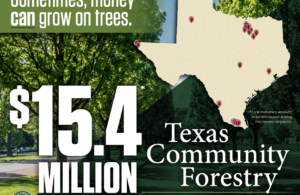- La Feria Native Soon To Retire From The Military This Summer
- Senior Eneece Avila Takes Pride in her State Title
- Dr. Noemi Infante, Harlingen Medical Center Open New Women’s Clinic
- Santa Rosa Cameron County Park Partially Reopens
- Santa Rosa Takes to Regionals Meet in Kingsville, Tx
- Long-Standing Nexstar Tower in La Feria Decommissioned
- Lionettes Powerlifting Meet
- Local Business Holds Event to Benefit RGV Shriners Club
- Knights of Columbus Holds it’s 30th Annual Golf Tournament
- KGBT Tower Dismantled
Report: TX Cities Need Policies to Control Stormwater Runoff
- Updated: September 29, 2017

A new report finds that urban waterways in Texas such as the San Antonio River could benefit from green infrastructure to control flooding and pollution from stormwater runoff. Photo: Warshaw/GettyImages
by Mark Richardson
AUSTIN, Texas – Rain is the lifeblood of Texas, but a new study shows that when there’s too much of it, the state’s major cities need to do more to prevent stormwater damage.
While incidents such as Hurricane Harvey are extreme examples of urban flooding, a report by Environment Texas shows that most Texas cities have too few public policies promoting green infrastructure and low-impact development in both public and private developments.
Brian Zabcik, a clean-water advocate with Environment Texas and the author of the report, says while poor storm water controls are a major contributor to urban flooding and erosion, the proper use of green infrastructure can make a big difference.
“Smaller amounts that the green infrastructure can capture means that if you use it on a wide scale, it is very effective in addressing the flooding that comes from smaller storm events that happen much more frequently,” he explains.
He says green infrastructure goes beyond traditional flood-control systems such as channels and culverts, to include things such as green roofs, permeable pavements and rainwater-harvesting systems. Texas’ largest cities were ranked on their policies promoting green infrastructure, with Austin at 90 percent, San Antonio at 65, Fort Worth at 60, Dallas at 50 and Houston at 40 percent.
Zabcik says stormwater runoff not only causes flooding in overbuilt urban areas but also is a significant source of pollution. He says green infrastructure also works to keep pollutants out of urban waterways.
“A commonly accepted set of design features, buildings and landscape designed to retain rainwater and either let it soak into the ground or filter surface pollutants out of it before it flows offsite,” he adds.
Zabcik says while cities can mandate low-impact development through building codes, local planners must provide proper incentives to induce citizens and private builders to include green infrastructure on their properties.






